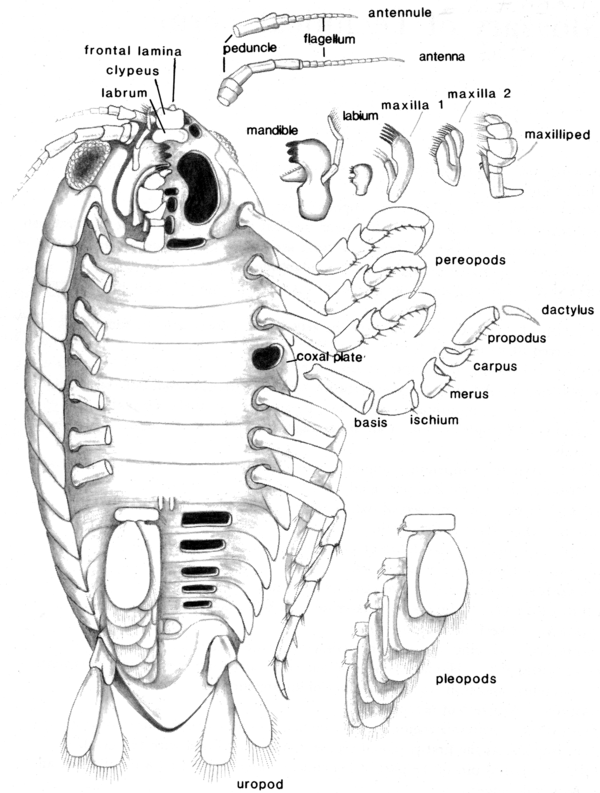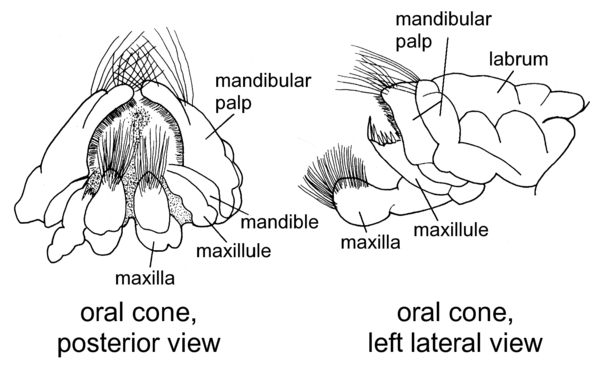- maxilla
- Appendage next behind maxillule serving functions in feeding and respiration. (Syn. second maxilla) [Moore and McCormick, 1969].One of a pair of two sets gnathal appendages situated immediately posteroventral to mandibles [Hobbs and Jass, 1988].One of a pair of two sets of appendages lying immediately posterior to the mandible [Hobbs, Hobbs, and Daniel 1977].One of two paired appendages in mouth region, posterior to (above in ventral view) mandible. (Pl. maxillae) [Butler, T.H.].Paired appendage of 5th cephalic somite, used in feeding, often also in respiration. (Pl. maxillae) (Syn. 2nd maxilla) [McLaughlin, 1980].Paired mouthpart appendages of the fourth and fifth cephalic somites. (Pl. maxillae) [Perez Farfante and Kensley, 1997].Paired mouthparts used to filter food particles from the water. They are located immediately posterior to the mandibles and labia, and are usually laminar in form [Mauchline, 1984].The third paired mouthpart and fifth cephalic appendage. In the Janiroidea, it consists of a basal segment bearing three setose lobes [Wilson, 1989].Third limb of cephalon, small, complex and membranous. (Syn. maxilla 2) [Poore, 2004].(Order Cladocera):Fifth and last paired appendage of head. Typically absent, yet if present, then reduced to tiny lobe. Associated with opening of maxillary gland. (absent, rudimentary). (Syn. second maxilla) [Stachowitsch, 1992].(Order Notostraca):Fifth paired appendage of head; located between maxillules and first thoracopods. Associated with opening of maxillary gland. (with well-developed lobe, reduced, absent). (Syn. second maxilla) [Stachowitsch, 1992].(Order Diplostraca):Fifth paired appendage of head; located between maxillules and first trunk appendages. If present, tiny, setose, and lobe-like. Associated with opening of maxillary gland. (vestigial, absent). (Syn. second maxilla) [Stachowitsch, 1992].(Order Anostraca):Fifth paired appendage of head; located between maxillules and first thoracopods, relatively small, reduced to simple lobe. (Syn. second maxilla) [Stachowitsch, 1992].(Class Cephalocarida):Fifth paired appendage of head (cephalon); located between maxillules and first thoracopods. Consists of protopod with five to six endites and large pseudepipod, six-segmented endopod, and two-segmented exopod.Basically biramous, although occasionally referred to as tri-, multi-, or polyramous due to numerous endites and pseudepipod. (Syn. second maxilla) [Stachowitsch, 1992].(Order Cumacea):Fifth paired appendage of head (cephalon); located between maxillules and first maxillipeds. Represents third pair of mouthparts and consists of base (protopod) with two endites as well as lateral flabellum (exopod). (Syn. second maxilla) [Stachowitsch, 1992].(Order Tanaidacea):Fifth paired appendage of head; located between maxillules and maxillipeds. Represents third pair of mouthparts and, if fully developed, consists of protopod bearing two endites. May be reduced to simple lobe. Mouthparts may be absent in male [Stachowitsch, 1992].(Order Decapoda):Third paired mouthpart on underside of head; borne on fifth cephalic segment (maxillar somite) and located between maxillule and first maxilliped. Typically consists of protopod, two endites, palp, and scaphognathite. (Syn. second maxilla) [Stachowitsch, 1992].(Order Amphipoda):Fifth paired appendage of head (cephalon); located between maxillules and maxillipeds. Represents third pair of mouthparts. Relatively small, consisting of base and two endites. (Syn. second maxilla) [Stachowitsch, 1992].(Order Isopoda):(1 and 2). Two sets of paired mouthpart appendages immediately posterior to mandible [Kensley and Schotte, 1989].(
 )Schematic representation of an isopod illustrating morphological terms. [Kensley and Schotte, 1989](Order Isopoda):Fifth pair of head appendages, functioning as mouthparts, immediately posterior to maxillules (=second maxillae). (Pl. maxillae) [Wetzer et al. 1997].(
)Schematic representation of an isopod illustrating morphological terms. [Kensley and Schotte, 1989](Order Isopoda):Fifth pair of head appendages, functioning as mouthparts, immediately posterior to maxillules (=second maxillae). (Pl. maxillae) [Wetzer et al. 1997].( )Nomenclature of isopod cephalon (A). Examples of isopod mouth appendages: Idoteidae (B, C, F, H); Cirolanidae (D, E, G, I). [Wetzer et al. 1997](Order Isopoda):Fifth paired appendage of head (cephalon); located between maxillules and maxillipeds. Represents third pair of mouthparts. Relatively small, consisting of base and two or three endites. (Syn. second maxilla) [Stachowitsch, 1992].(Order Mysida):Fifth paired appendage of head; located between maxillules and maxilipeds. Represents third pair of mouthparts and consists of base bearing two to three endites, two-segmented endopod (palp), and exopod. (Syn. second maxilla) [Stachowitsch, 1992].(Order Stomatopoda):Third paired mouthpart on underside of head (cephalon); borne on fifth cephalic somite and located posterior and external to maxillules. Conists of four segments, the first being cylindrical, the others flattened; segments one and two with endites (that of second is bilobed). Bears opening of maxillary gland. (Syn. second maxilla) [Stachowitsch, 1992].(Order Leptostraca):Fifth paired appendage of head (cephalon); located between maxillules and first pair of thoracopods. Represents third pair of mouthparts and, if fully developed, consists of proximal section with four endites as well as distal branches (endopod and exopod). Maxillary glands open at base of maxillae. (Syn. second maxilla) [Stachowitsch, 1992].(Subclass Branchiura):Paired appendage on underside of head between maxillules (suction discs) and first thoracopods. Uniramous, consisting of several spinose segments and terminal claw. Bears basal plate and opening of maxillary gland basally. (Syn. second maxilla) [Stachowitsch, 1992].(Subclass Cirripedia):(
)Nomenclature of isopod cephalon (A). Examples of isopod mouth appendages: Idoteidae (B, C, F, H); Cirolanidae (D, E, G, I). [Wetzer et al. 1997](Order Isopoda):Fifth paired appendage of head (cephalon); located between maxillules and maxillipeds. Represents third pair of mouthparts. Relatively small, consisting of base and two or three endites. (Syn. second maxilla) [Stachowitsch, 1992].(Order Mysida):Fifth paired appendage of head; located between maxillules and maxilipeds. Represents third pair of mouthparts and consists of base bearing two to three endites, two-segmented endopod (palp), and exopod. (Syn. second maxilla) [Stachowitsch, 1992].(Order Stomatopoda):Third paired mouthpart on underside of head (cephalon); borne on fifth cephalic somite and located posterior and external to maxillules. Conists of four segments, the first being cylindrical, the others flattened; segments one and two with endites (that of second is bilobed). Bears opening of maxillary gland. (Syn. second maxilla) [Stachowitsch, 1992].(Order Leptostraca):Fifth paired appendage of head (cephalon); located between maxillules and first pair of thoracopods. Represents third pair of mouthparts and, if fully developed, consists of proximal section with four endites as well as distal branches (endopod and exopod). Maxillary glands open at base of maxillae. (Syn. second maxilla) [Stachowitsch, 1992].(Subclass Branchiura):Paired appendage on underside of head between maxillules (suction discs) and first thoracopods. Uniramous, consisting of several spinose segments and terminal claw. Bears basal plate and opening of maxillary gland basally. (Syn. second maxilla) [Stachowitsch, 1992].(Subclass Cirripedia):( ) [Anderson, 1980].Balanus trigonus: oral cone, posterior view; and oral cone, lefft lateral view. [Anderson, 1980](Subclass Cirripedia):Third paired mouthpart on head. Consists largely of gnathobase; associated with openings of maxillary glands. (fused, not fused) (see also oral pyramid). (Syn. second maxilla) [Stachowitsch, 1992].(Subclass Copepoda):The fifth and last pair of cephalic appendages [Boxshall and Halsey, 2004].(Subclass Mystacocarida):Fifth paired appendage of cephalon; located between maxillules and maxillipeds. Uniramous, consisting of protopod (with endites) and four-segmented shaft. Serves in locomotion and feeding. (Syn. second maxilla) [Stachowitsch, 1992].(Class Ostracoda):Third paired mouthpart on underside of head; located between maxillules and maxillipeds. Uniramous, either setose and serving in suspension feeding, with terminal hooks/spines and serving as a raptorial organ, or arm-like and modified for attachment to host. Bears opening of maxillary gland basally. The term second maxilla is often preferentially applied. (Syn. second maxilla) [Stachowitsch, 1992].(Class Remipedia):Third paired mouthpart on underside of head (cephalon) posterior to maxillules. Uniramous, consisting of six or seven segments, and with main point of flexure between third and fourth segments. First two or three segments bear endites, the last bears terminal claw; all segments bear setae along inner margin. (prehensile, subchelate). (Syn. second maxilla) [Stachowitsch, 1992].(Superorder Syncarida):Fifth paired appendage of head; located between maxillules and maxillipeds or between maxillules and first thoracopods. Represents third pair of mouthparts and bears two to four endites. (Syn. second maxilla) [Stachowitsch, 1992].(Order Thermosbaenacea):Fifth paired appendage of cephalon; located between maxillules and maxillipeds. Represents third pair of mouthparts and consists of protopod bearing three endites, palp (endopod), and small lobe (exopod). (Syn. second maxilla) [Stachowitsch, 1992].(Order Euphausiacea):Fifth paired appendage of head (cephalon); located between maxillules and first thoracopods. Represents third pair of mouthparts and, if fully developed, consists of three-segmented base (protopod) with two endites as well as distal endopod (palp) and exopod. (foliaceous). (Syn. second maxilla) [Stachowitsch, 1992].
) [Anderson, 1980].Balanus trigonus: oral cone, posterior view; and oral cone, lefft lateral view. [Anderson, 1980](Subclass Cirripedia):Third paired mouthpart on head. Consists largely of gnathobase; associated with openings of maxillary glands. (fused, not fused) (see also oral pyramid). (Syn. second maxilla) [Stachowitsch, 1992].(Subclass Copepoda):The fifth and last pair of cephalic appendages [Boxshall and Halsey, 2004].(Subclass Mystacocarida):Fifth paired appendage of cephalon; located between maxillules and maxillipeds. Uniramous, consisting of protopod (with endites) and four-segmented shaft. Serves in locomotion and feeding. (Syn. second maxilla) [Stachowitsch, 1992].(Class Ostracoda):Third paired mouthpart on underside of head; located between maxillules and maxillipeds. Uniramous, either setose and serving in suspension feeding, with terminal hooks/spines and serving as a raptorial organ, or arm-like and modified for attachment to host. Bears opening of maxillary gland basally. The term second maxilla is often preferentially applied. (Syn. second maxilla) [Stachowitsch, 1992].(Class Remipedia):Third paired mouthpart on underside of head (cephalon) posterior to maxillules. Uniramous, consisting of six or seven segments, and with main point of flexure between third and fourth segments. First two or three segments bear endites, the last bears terminal claw; all segments bear setae along inner margin. (prehensile, subchelate). (Syn. second maxilla) [Stachowitsch, 1992].(Superorder Syncarida):Fifth paired appendage of head; located between maxillules and maxillipeds or between maxillules and first thoracopods. Represents third pair of mouthparts and bears two to four endites. (Syn. second maxilla) [Stachowitsch, 1992].(Order Thermosbaenacea):Fifth paired appendage of cephalon; located between maxillules and maxillipeds. Represents third pair of mouthparts and consists of protopod bearing three endites, palp (endopod), and small lobe (exopod). (Syn. second maxilla) [Stachowitsch, 1992].(Order Euphausiacea):Fifth paired appendage of head (cephalon); located between maxillules and first thoracopods. Represents third pair of mouthparts and, if fully developed, consists of three-segmented base (protopod) with two endites as well as distal endopod (palp) and exopod. (foliaceous). (Syn. second maxilla) [Stachowitsch, 1992].
Crustacea glossary. Natural History Museum of Los Angeles County. 2011.
